Cover Girl
In the 1950s, the Noxzema Chemical Company of Baltimore, Maryland – known mainly for their Noxzema Skin Cream – began a program of diversification. It hired new staff with experience in sales, advertising and product development, and started creating and market testing new lines.
Amongst the new products brought to fruition were two medicated cosmetics, a liquid make-up and a compressed powder. First sold nationally in January, 1961, they were introduced with an extensive magazine and television advertising campaign targeting teenagers and young women. The products sold well and Noxzema added a loose powder to the line later in the year.
This modest beginning marked the start of the incredibly successfully Cover Girl brand. Noxzema had some experience with skin-care cosmetics but the company had never sold make-up before so the ‘overnight’ success of Cover Girl was quite remarkable.
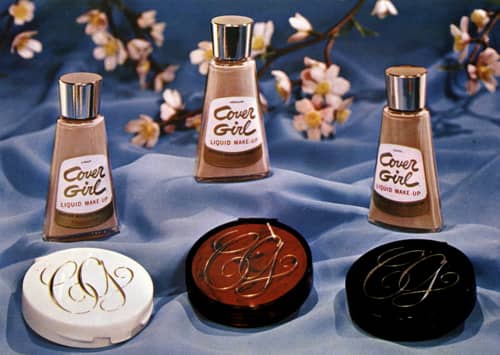
Above: 1961 Cover Girl Liquid Make-up and Cover Girl Compressed Powder in three shades. A differently coloured compact was made for each shade: White for Light; Red for Medium; and Brown for Dark. The Dark shade was subsequently renamed as Brunette.
Medicated Make-up
Cover Girl was formulated with some of the medicinal compounds already used in Noxzema Skin Cream – such as camphor, menthol, clove oil and eucalyptus oil – but also included the bactericides methylparahydroxybenzoate, propylparahydroxybenzoate and hexachlorophene. As bacteria are associated with pimples and other skin blemishes, the inclusion of parahydroxybenzoates and hexachlorophene allowed Noxzema to claim that Cover Girl was ‘really good for the skin’ and ‘better than not using make-up at all’.
In October, 1972, the U.S. Food and Drug Authority (FDA) restricted the use of hexachlorophene but Noxzema – by then renamed the Noxell Corporation – had pre-empted the FDA announcement and removed the substance from its lines earlier in the year. However, as Cover Girl make-up still contained other bactericides the company could still describe the cosmetics as medicated.
See also: Hexachlorophene
The idea of developing a medicated make-up line may have come from Mary Ayers who worked for the advertising agency Sullivan, Stauffer, Colwell & Bayles (SSC&B). She had previously suggested increasing Noxzema Skin Cream’s market share by promoting it to women as a medicated facial cleanser and water-soluble beauty cream.
[T]he most popular acne treatment for teens was a flesh-colored medicine called Clearasil, a slightly opaque ointment that came in a tube and had a distinctive, rather unpleasant, scent. Mary suggested to her client that Noxzema also develop a medicated, flesh-colored product, but make it opaque enough to cover the skin like a makeup and produce a range of shades. The treatment would actually contain Noxzema, which smelled more medicinal than most cosmetics, but had a more pleasant odor than most acne applications.
(Scott, 2013)
Others have suggested that it was Noxzema’s vice president of new product development, William (Bill) Hunt, who came up with the initial proposal.
The name ‘Cover Girl’ appears to have originated with Carolyn Oelbaum, a junior copywriter who also worked for SSC&B (Scott, 2013). It was a good choice as it suggested that the make-up ‘covered’ while at the same time opened up the possibility of using models on the covers of magazines as the basis for an advertising campaign.
Unfortunately, Crystal Products trademarked Cover Girl in Britain in 1962; however, they ceded it to Noxzema in 1964.
Youth market
As the target audience for Cover Girl was teenagers and young women, the cosmetics were packaged for sale in drug and grocery stores where most price-sensitive young women bought their cosmetics and most other Noxzema products were sold.
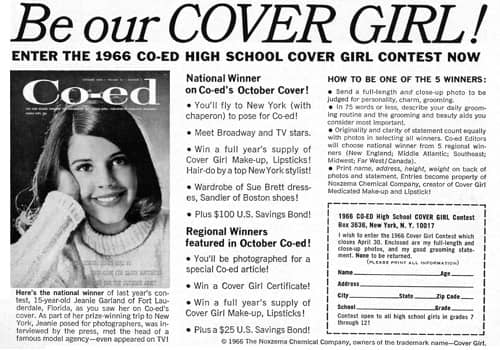
Above: 1966 Co-Ed High School Cover Girl Contest. These contests began in 1962 and suggest that Noxzema targeted late teens very early on. The first winner was Nora Schraeder, aged 17.
Initially, the three Cover Girl make-up lines – liquid, compressed and loose powder – were only sold in three shades – Light, Medium, and Dark but this was extended to four – Creamy Light, Light, Medium, and Brunette by 1964. However, this meant that Cover Girl was still only suitable for individuals with lighter skins.
To promote sales, customers were encouraged to buy more that one shade of Cover Girl and use them for contouring.
USE LIGHTER SHADES to accentuate or bring forward features that need emphasizing.
Receding chin? Carefully blend a light shade of foundation over the jawline from ear to chin.
Nose too small or retroussé Lightly blend a streak of lighter makeup right down the center of the nose over your regular shade.
Circles or lines under eyes? Blend a very light foundation over these areas first, then apply your regular liquid make-up shade over it.
USE DARKER SHADES for contrast or to diminish features that may appear too prominent.
Face too round or too square? Blend darker base or powder nest to jawline from ears to chin in a long triangle.
Nose too long? Apply darker base over the tip only.
Nose too wide? First apply darker base along the sides of nose, blending carefully into adjoining areas. Then apply regular make-up shade over your entire nose.(Cover Girl advertisement, 1964)

Above: 1963 Cover Girl counter display case.
When Cover Girl Lipsticks were added in 1964, this idea was used again, with suggestions to mix different lipstick colours to create an individual shade or look.
Experiment with color, mix and match several shades of Cover Girl Lipstick. Try outlining your lips with one color, filling in with another.
(Cover Girl, 1964)
See also: Corrective Make-up (Contouring)
Promotion
By 1962, Cover Girl had achieved sales volumes well over half of the all time record for Noxzema Skin Cream, something that must have astonished the company. Much of the credit for this success lies with the SSC&B television and print advertising campaign.
The SSC&B campaign that the agency devised for Cover Girl combined models and known magazine mastheads. This required SSC&B to get agreement from magazines such as ‘Redbook’, ‘McCall’s’, ‘Teen’, ‘Women’s Day’, ‘Harper’s Bazaar’, ‘Vogue’, ‘Glamour’, ‘Co-Ed’, ‘Life’ and ‘Look’ to use their mastheads in Cover Girl advertising. Pressure from other cosmetic companies such as Revlon caused many of these magazines to rescind these agreements within a year or two but by then the Cover Girl brand was well established. Not all of the magazines capitulated and those that were still available to Cover Girl continued to be used in advertising for some time to come.
Television advertising was critical to the success of the brand. As Hazel Bishop and Revlon had demonstrated in the 1950s, this relatively new medium could be very effective in selling cosmetics.
Above: Cover Girl Make-up by Noxzema.
See also: Revlon and ‘The $64,000 Question’
The success of Cover Girl soon had other cosmetic companies like Revlon, Max Factor and Chesebrough-Pond’s adding medicated make-up ranges – in some cases also using hexachlorophene – but these new entries failed to stop the expansion of the Cover Girl brand.
Models
The Cover Girl campaign is sometimes credited with starting the trend of using named models in advertising leading to the development of what is now known as the ‘supermodel’. Although overstated, Cover Girl was the first brand to widely use identified models across print, radio and television and this elevated the status of models and turned many of them into household names.
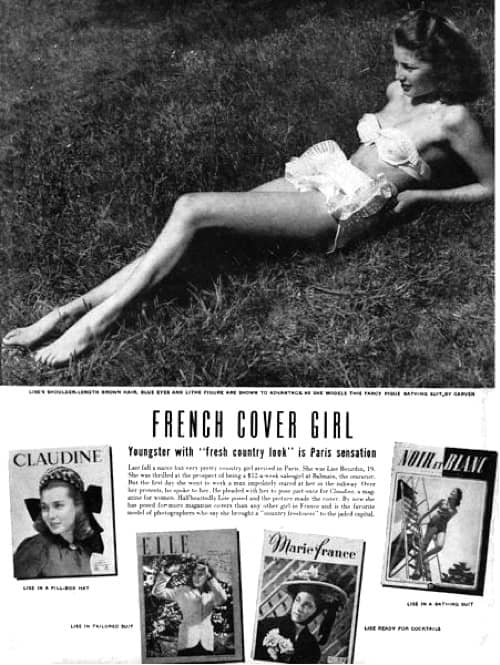
Above: 1946 article from LIFE magazine that reflects a growing interest in models.
Clean make-up
In 1968, Noxell shifted gear and began advertising Cover Girl as ‘Clean Makeup’.
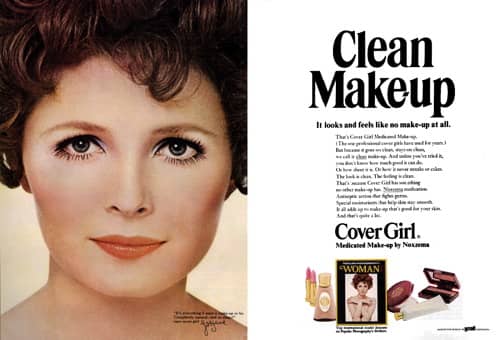
Above: 1968 Cover Girl Clean Make-up.
It looks and feels like no other make-up at all.
That’s Cover Girl Medicated Make-up.
(the one professional cover girls have used for years.)
But because it goes on clean, stays on clean, we call it clean make-up. And unless you’ve tried it, you don’t know how much good it can do.
Or how sheer it is. Or how it never streaks or cakes.
The look is clean. The feeling is clean.
That’s because Cover Girls’s has something no other make-up has. Noxzema medication.
Antiseptic action that fights germs.
Special moisturizers that help the skin stay smooth.
It all adds up to make-up that’s good for your skin.
And that’ quite a lot.(Cover Girl advertisement, 1968)
Brunette models were used in the ‘Clean Makeup’ advertising but blondes – such as Cybill Shepherd [b. 1950] – tended to predominate as they looked cleaner and fresher.
Extending the range
In 1962, Noxzema added Cover Girl Matte Make-up, a cream make-up sold in a tube.
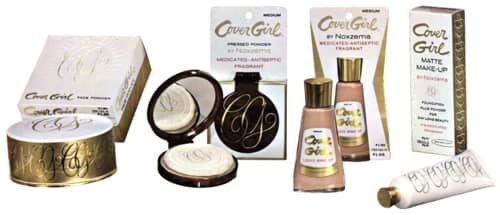
Above: 1962 Cover Girl range: loose powder, compressed powder, liquid and cream matte make-up.
In 1964, Cover Girl Lipsticks were introduced in eight shades (Real Red, Clear Crimson, Pure Scarlet, True Rose, Natural Peach, Pink Beige, Pastel Pink, and Natural Frost) with frosty shades (Beige Caper, Pink Whim, Bare Minimum, and Orange Fling) and two lip toners (Boss Gloss, and Bold Gold) added in 1966, and near-neon ‘Flasher’ shades (Natural Flash, Amber Flash, Pink Flash, and Lightning Flash) released in 1967.
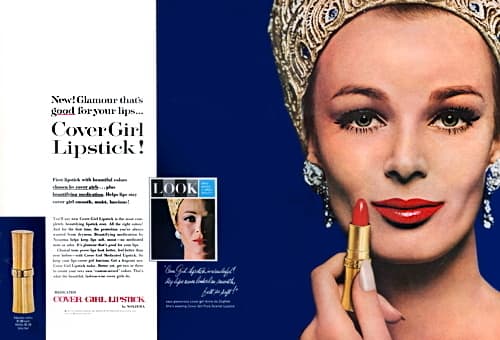
Above: 1964 Cover Girl Lipsticks.
All of these products were made and packaged by private label firms. In 1966, Noxell decided to move some of this manufacturing in-house. It opened a new plant in Cockeysville, Baltimore County, Maryland and, by the following year, this factory was used to make packaging for Cover Girl cosmetics and assemble the various lines using product delivered in bulk from private providers.
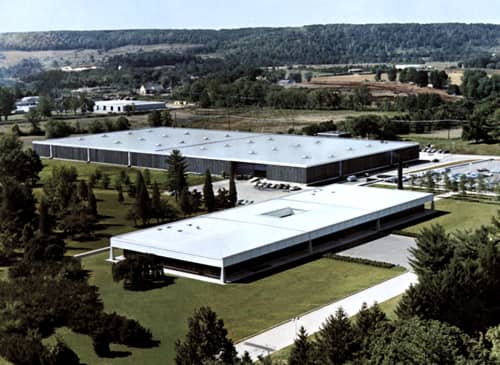
Above: 1968 Cockeysville factory.
Full-scale manufacture in-house of some Cover Girl cosmetics – Cover Girl liquid and tube make-up and Cover Girl Plus 3 – did not commence at Cockeysville until 1968, by which time Cover Girl Liquid Make-up was the top-selling make-up line in the United States, with Cover Girl Pressed Powder coming in second. The high demand for Cover Girl products might explain why Noxell introduced new pilfer-proof packaging for the Cover Girl range in that year.
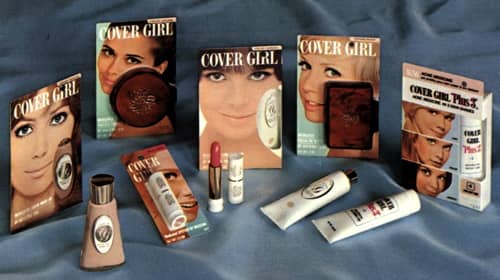
Above: 1969 Cover Girl products in new packaging.
Other Cover Girl lines added in the 1960s included: Glow Lightly, a brush-on blusher in three shades (1967); Plus 3, an acne remedy in three shades (1968); and Pearlies lipsticks in four shades (1969).
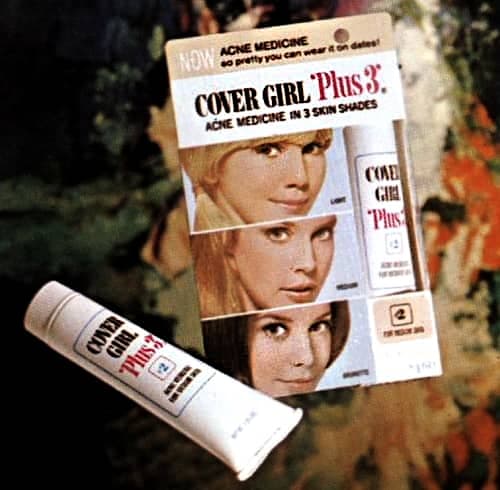
Above: 1969 Cover Girl Plus 3 acne treatment in three shades: Light, Medium and Brunette.
See also: Your Winning Look by Cover Girl (1969).
In 1970 – the same year that Max Factor launched its Pure Magic Super-Sheer Medicated Make-up line – Noxell introduced a range of Cover Girl Super Sheer cosmetics better suited to the prevailing ‘natural look’. The range started with three products: Cover Girl Super Sheer Liquid, a foundation in Sheer Bare, Sheer Buff, Sheer Blush, and Sheer Beige shades; Cover Girl Translucent Powder, a pressed powder in Sheer Nude, and Sheer Natural shades; and Cover Girl Translucent Blusher Duo, a double-panned blusher in Sheer Peach/Peach Glow or Sheer Pink/Pink Glow sets.
The following year, Noxell released Cover Girl Eyes Make-up (1971), a line of 47 products that included mascaras, eyeshadows and eyebrow pencils.
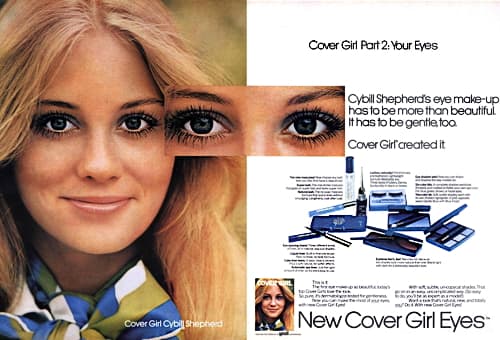
Above: 1971 Cover Girl Eyes.
Other make-up lines introduced in the 1970s included: Cover Girl Gloss & Gleam, a compact blusher and lip gloss, Super Gloss for Lips (Super Sheen line), and Shiny Shadow, a cream eyeshadow in pots (1972); PeeperSticks eyeshadow crayons (1973); Cover Girl Long ’n Lush Mascara, Softline Eyeliner, Softline Eye Shadow, and Moisturized Big Eye Shadow (1974); 9-Hour Eye Polish, a liquid shadow and liner in one; Cover Girl Shiny Lipsticks (1975); Cover Girl One-Stroke Eye Colors (1976); and Professional Mascara, Color-Matics Eye Shadow, and 9-Hour Cheek Color, a liquid blush (1978).
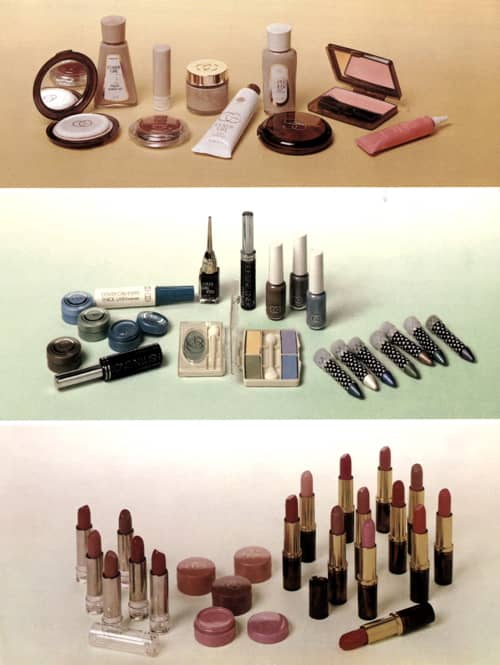
Above: 1975 Cover Girl make-up range. Top: Cover Girl foundations, compressed powders, concealer and blushers. Middle; Cover Girl eye make-up. Bottom: Cover Girl lipstick and lip pots.
When Cover Girl Nailslicks nail polishes were added in 1977, Cover Girl now had products in each of the main categories of make-up: face, eyes, lips and nails.
Realising that its initial target audience was growing up, Noxell also began to introduce Cover Girl products for women who were 25 years or older. Starting with Cover Girl Moisture Make-up, and Cover Girl Moisturizing Cover Stick in 1973, Noxell added three additional cosmetics in 1976 – Moisture Cream Make-up, Moisture Cream Blush, and Moisture Encapsulated Pressed Powder – thereby creating the Cover Girl MoistureWear Make-up range.
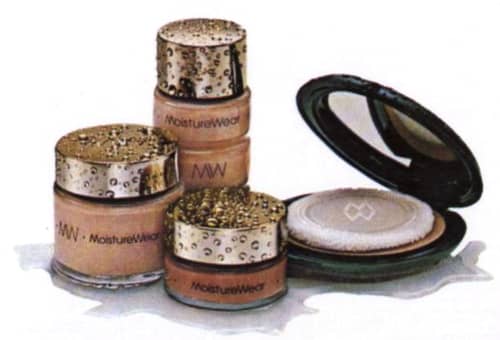
Above: 1979 Cover Girl MoistureWear Make-up Collection.
Also, in 1976, Noxell added Cover Girl All-Day Oil Control Liquid Make-up in five shades, later complementing it with Oil Control Translucent Powder (1978), also in five shades, and Oil Control Powder Blush (1981). The company now had three lines of face make-up based on skin type: Regular for normal skins, Oil Control for oily skins, and MoistureWear for dry or older skins.
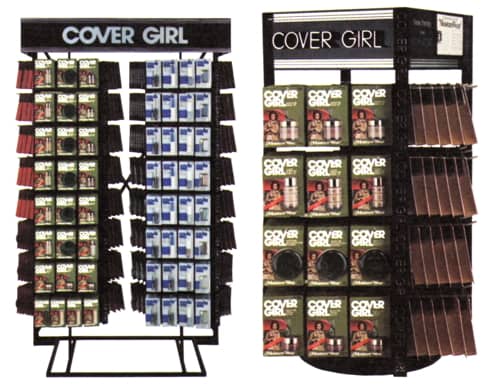
Above: 1976 Cover Girl make-up display stands.
Overseas markets
Although Cover Girl was very successful in the United States and Canada, Noxell did not rapidly globalize the brand. Noxzema had not been marketed globally so when it came to selling Cover Girl overseas, Noxell tended to rely on exporting or licensing agreements. The first foreign branch was opened in Britain in 1964 but it was not unti 1977 that the Noxell Corporation (U.K.) Ltd. was established and manufacturing began there. By 1977, Cover Girl was being distributed in nine European countries and – through an arrangement with Lion Dentrific Co. Ltd. in 1973 – was also sold in Japan. However, sales outside of North America were modest.
In North America, the line continued to strengthen in the 1980s achieving sales that were better than Maybelline, making Cover Girl the leading mass-marketed cosmetics line in the United States at the time. Both companies committed large amounts of money to advertising, particularly television, and it is estimated that Noxell was spending US$20 million on Cover Girl advertising or about 20% of its sale’s earnings by 1980.
Later developments
Cover Girl’s premier position attracted the attention of Procter & Gamble – which did not have a make-up line in its stable of products at the time – and, in a stock-swap deal valued at US$1.3 billion, Procter & Gamble acquired the Noxell Corporation in 1988. Procter & Gamble operated the brand until 2016 when, as part of a major reorganisation, they sold Cover Girl and 42 other brands to Coty.
Timeline
| 1961 | New Products: Cover Girl Liquid Make-up; Cover Girl Compressed Powder; and Cover Girl Face Powder. |
| 1962 | New Products: Cover Girl Matt Make-up, a foundation and powder in one. |
| 1964 | New Products: Cover Girl Lipstick. |
| 1965 | Cover Girl manufactured abroad for the first time. |
| 1966 | Noxzema Chemical Company renamed the Noxell Corporation. Cockeysville plant opened. |
| 1967 | New Products: Cover Girl Glow Lightly. |
| 1968 | Improved pilfer-proof packaging introduced. New Products: Plus 3. |
| 1969 | New Products: Pearlies lipsticks. |
| 1970 | New Products; Cover Girl Super Sheer Liquid Make-up; Cover Girl Translucent Powder; and Cover Girl Translucent Blusher. |
| 1971 | New Products: Cover Girl Eyes Make-up. |
| 1972 | Hexachlorophene eliminated from Cover Girl products. New Products: Cover Girl Gloss & Gleam; Super Sheer Super Gloss for Lips; and Shiny Shadow. |
| 1973 | Royalty agreement reached with Lion Dentrific Co. Ltd. Japan to market Cover Girl and Noxzema in Japan. Lipstick reformulated and repackaged. New Products: PeeperSticks; Cover Girl Moisture Make-up; and Cover Girl Moisturizing Cover Stick. |
| 1974 | New Products: Cover Girl Long’n Lush Mascara; Softline Eye Shadow; and Moisturized Big Eye Shadow. |
| 1975 | Agreement signed with Beiersdolf AG, Hamburg to distribute Cover Girl in West Germany. New Products: 9-Hour Eye Polish; and Cover Girl Shiny Lipsticks. |
| 1976 | New Products: Cover Girl MoistureWear Make-up line; Cover Girl All-Day Oil Control Liquid Make-up; and Cover Girl One-Stroke Eye Colors. |
| 1977 | Noxell Corporation (UK) Ltd. established. New Products: Cover Girl Nailslicks. |
| 1978 | New Products: Professional Mascara; Color-Matics Eye Shadow; and 9-Hour Cheek Color. |
| 1979 | First company operated remote distribution centre opened in Chicago. |
| 1988 | Procter & Gamble acquires Noxell Corporation. |
| 2016 | Cover Girl sold to Coty. |
First Posted: 16th February 2016
Last Update: 14th March 2024
Sources
Jones, G. (2010). Beauty imagined: A history of the global beauty industry. Oxford: Oxford University Press.
Noxzema Chemical Company. Annual Reports 1959-1965.
Noxell Corporation. Annual Reports 1966-1979.
Scott, L. M. (2013). Classic campaigns – Cover Girl cosmetics: 1960-1990. Advertising & Society Review. 13(4). Retrieved February 2, 2016, from https://muse.jhu.edu/
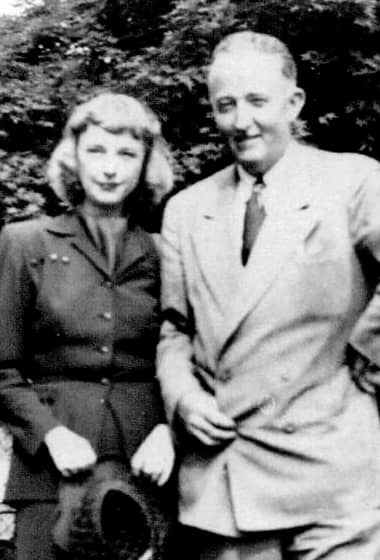
Raymond F. Sullivan and his secretary Mary Ayers in the 1930s. Sullivan was a board member of Noxzema in the 1930s and was also one of the founders of the Sullivan, Stauffer, Colwell & Bayles (SSC&B) advertising agency, created in 1946. Mary continued as Sullivan’s secretary at SSC&B, later becoming the account supervisor for Noxzema. At the agency level, Ayers and Sullivan were the people who worked mostly closely with Noxzema in the 1950s.
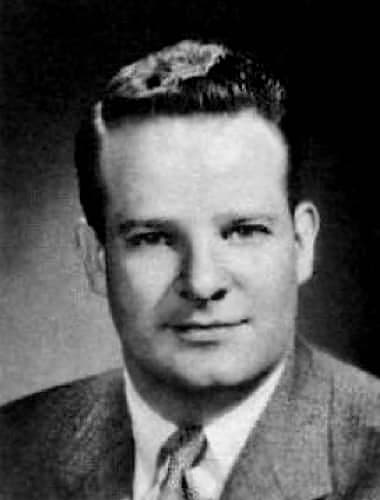
William D. Hunt, vice president of new product development.
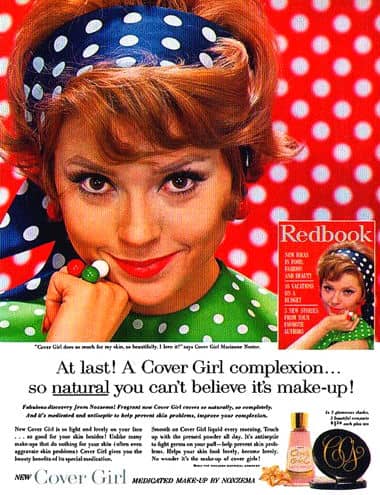
1961 Cover Girl liquid and compressed powder.
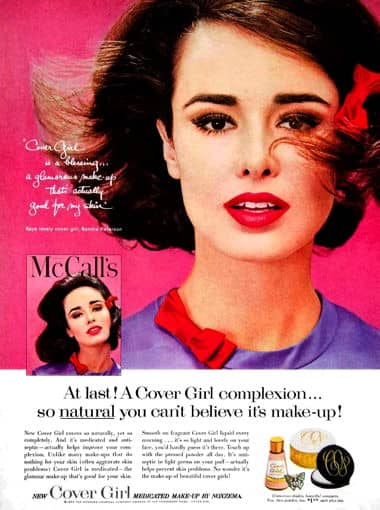
1962 Cover Girl liquid, compressed and loose powder.

1963 Cover Girl liquid, compressed and loose powder.
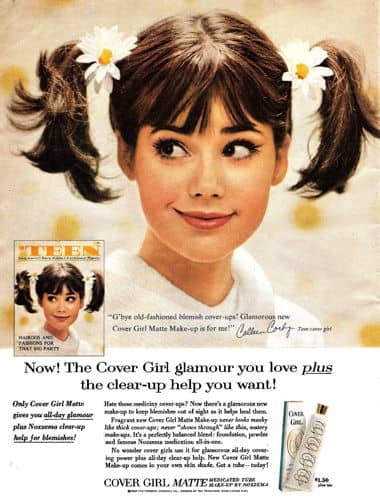
1963 Cover Girl Matt Make-up.
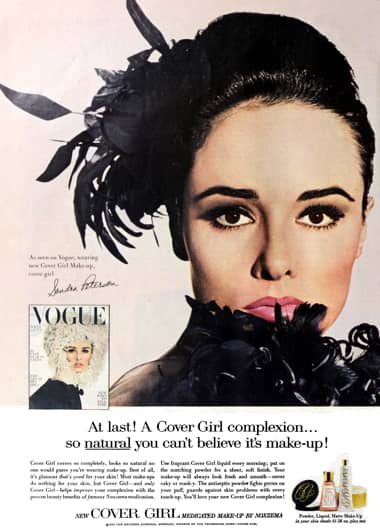
1964 Cover Girl Medicated Make-up.

1964 Cover Girl Lipstick. Young women were encouraged to mix and match. Here Teen model Kathi Bergen blends Pink Beige and Natural Peach then adds a pearly finish with Natural Frost.
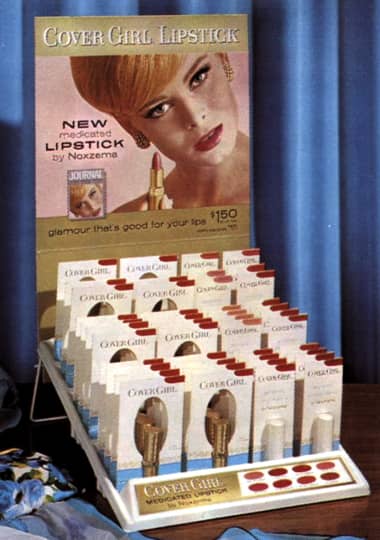
1964 Cover Girl Lipstick display stand. The eight lipstick shades on display are Real Red, Clear Crimson, Pure Scarlet, True Rose, Natural Peach, Pink Beige, Pastel Pink and Natural Frost.
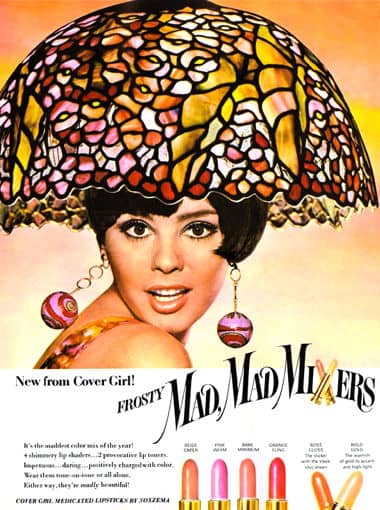
1966 Cover Girl Mad Mad Mixer Frosted Lipsticks in shades: Beige Caper, Pink Whim, Bare Minimum and Orange Fling. Also two lip toners in shades: Boss Gloss and Bold Gold.
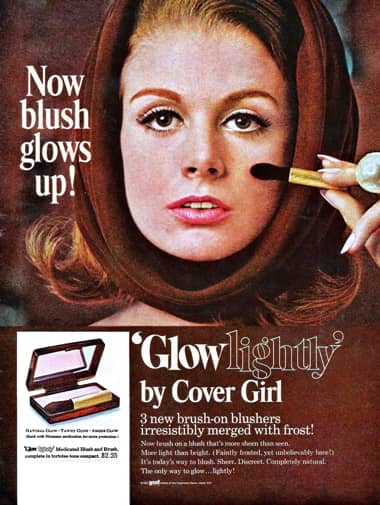
1967 Cover Girl Glow Lightly brush-on blusher in Natural Glow, Tawny Glow and Amber Glow shades.
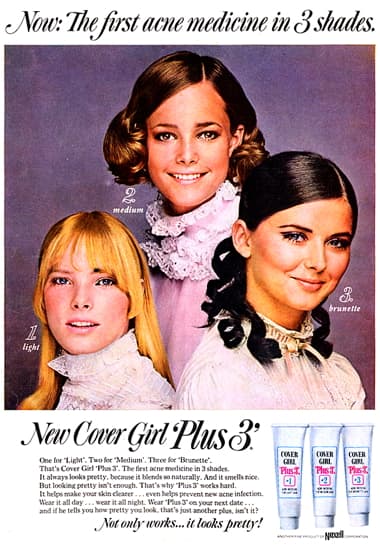
1968 Cover Girl Plus 3.
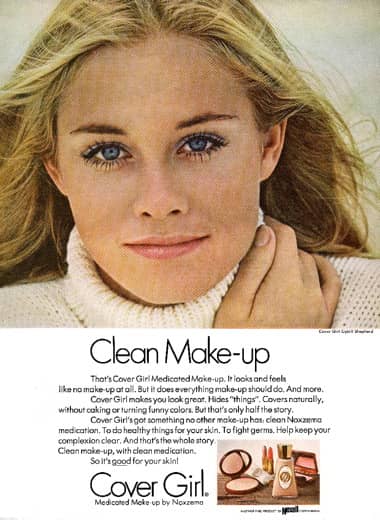
1969 Cover Girl Clean Make-up.
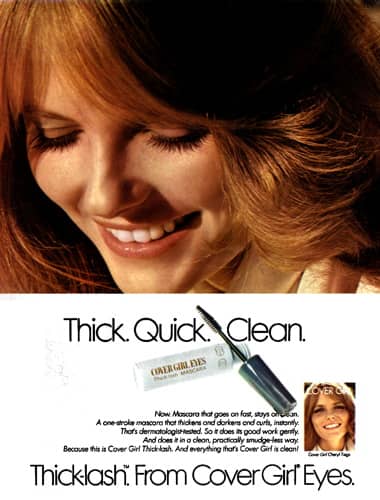
1973 Cover Girl Thick-Lash.
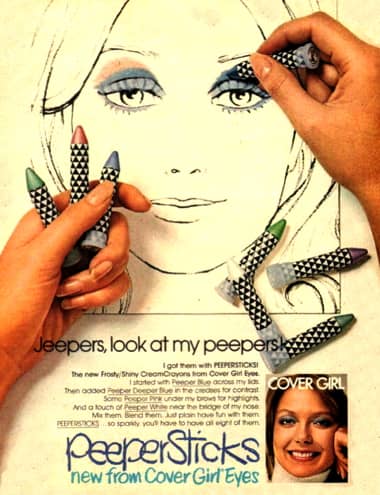
1974 Cover Girl PeeperSticks creamy crayon eyeshadows.
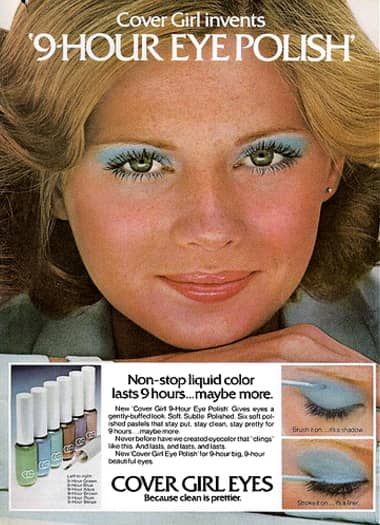
1975 Cover Girl 9-Hour Eye Polish, a liquid shadow and liner in one. Shades: 9-Hour Green, 9-Hour Blue, 9-Hour Aqua, 9-Hour Brown, 9-Hour Plum and 9-Hour Beige.
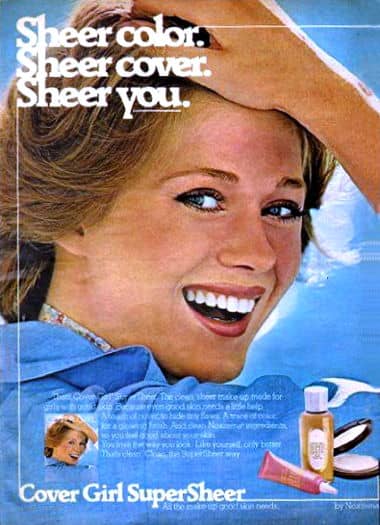
1976 Cover Girl Super Sheer Make-up.
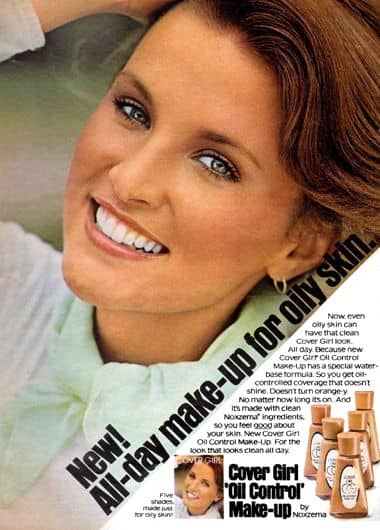
1976 Cover Girl Oil Control Liquid Make-up.
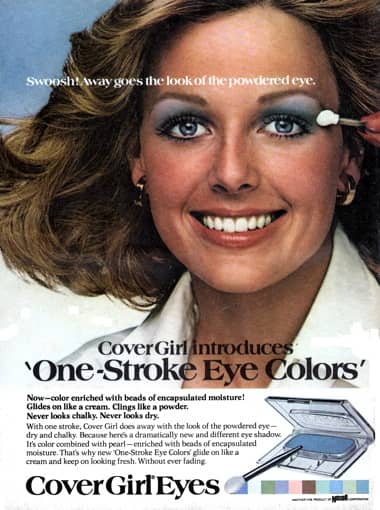
1976 Cover Girl One Stroke Eye Colors.
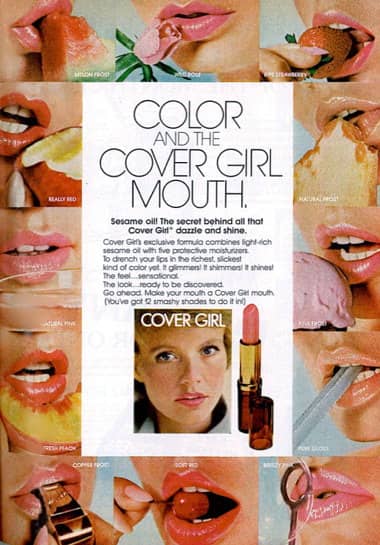
1976 Cover Girl Lipstick with sesame oil. Shades: Ripe Strawberry, Fresh Peach, Wild Rose, Copper Frost, Natural Frost, Pink Frost, Breezy Pink, Really Red, Pure Gloss, Melon Frost, Natural Pink and Soft Red.
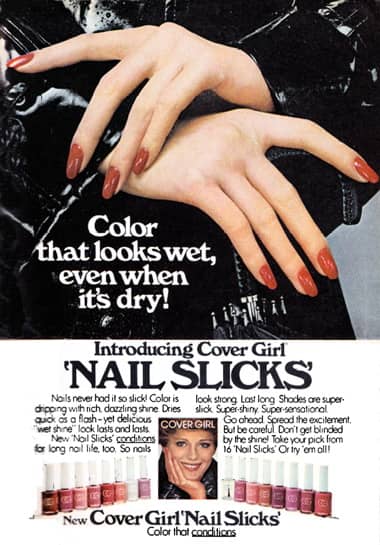
1977 Cover Girl Nail Slicks.
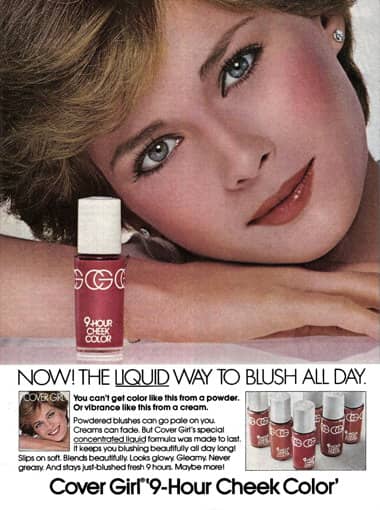
1978 Cover Girl 9-Hour Cheek Color. Shades: Pretty Rose, Fresh Apricot, Honey Bronze, Ripe Rasin, Wild Berry and Spun Cinnamon.
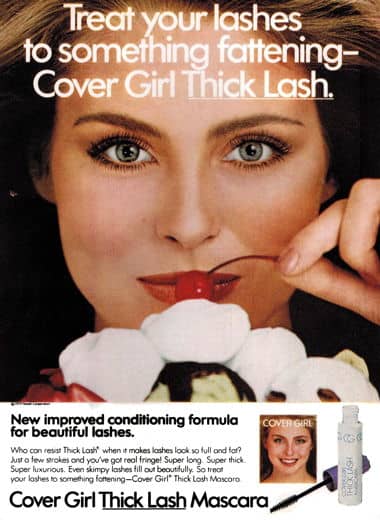
1979 Cover Girl Thick Lash Mascara.
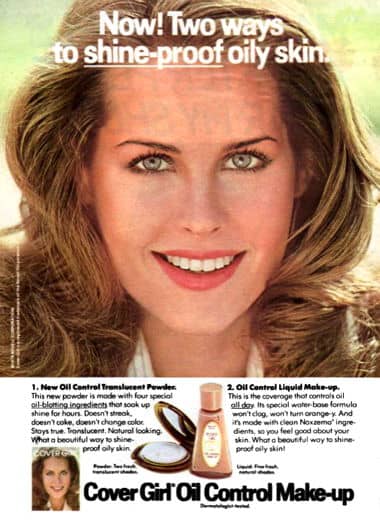
1979 Cover Girl Oil Control Translucent Powder and Liquid Make-up.
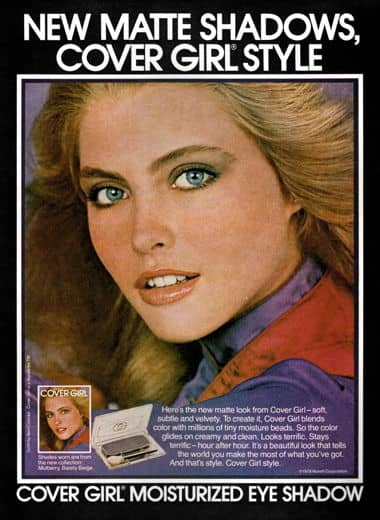
1979 Cover Girl Moisturized eye Shadow.
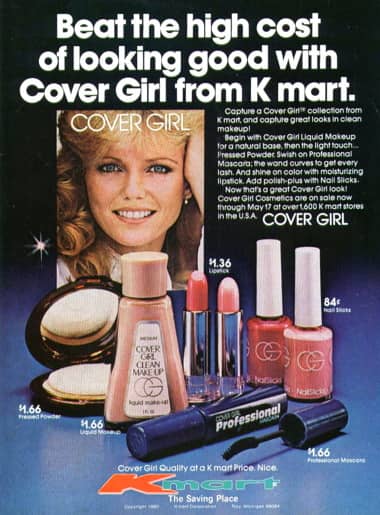
1980 Cover Girl cosmetics.
